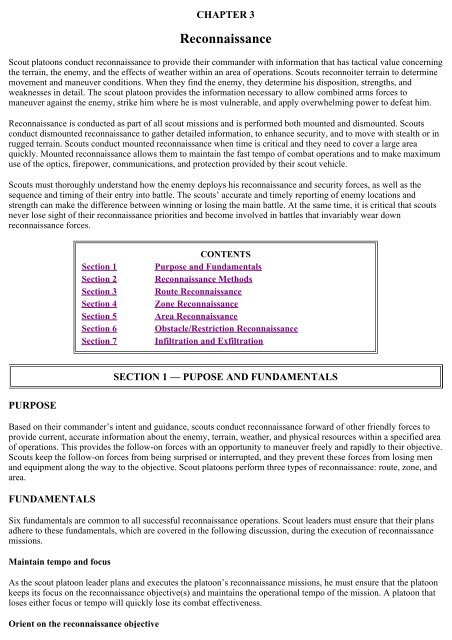FM 17-98 SCOUT PLATOON
FM 17-98 SCOUT PLATOON
FM 17-98 SCOUT PLATOON
Create successful ePaper yourself
Turn your PDF publications into a flip-book with our unique Google optimized e-Paper software.
CHAPTER 3<br />
Reconnaissance<br />
Scout platoons conduct reconnaissance to provide their commander with information that has tactical value concerning<br />
the terrain, the enemy, and the effects of weather within an area of operations. Scouts reconnoiter terrain to determine<br />
movement and maneuver conditions. When they find the enemy, they determine his disposition, strengths, and<br />
weaknesses in detail. The scout platoon provides the information necessary to allow combined arms forces to<br />
maneuver against the enemy, strike him where he is most vulnerable, and apply overwhelming power to defeat him.<br />
Reconnaissance is conducted as part of all scout missions and is performed both mounted and dismounted. Scouts<br />
conduct dismounted reconnaissance to gather detailed information, to enhance security, and to move with stealth or in<br />
rugged terrain. Scouts conduct mounted reconnaissance when time is critical and they need to cover a large area<br />
quickly. Mounted reconnaissance allows them to maintain the fast tempo of combat operations and to make maximum<br />
use of the optics, firepower, communications, and protection provided by their scout vehicle.<br />
Scouts must thoroughly understand how the enemy deploys his reconnaissance and security forces, as well as the<br />
sequence and timing of their entry into battle. The scouts’ accurate and timely reporting of enemy locations and<br />
strength can make the difference between winning or losing the main battle. At the same time, it is critical that scouts<br />
never lose sight of their reconnaissance priorities and become involved in battles that invariably wear down<br />
reconnaissance forces.<br />
Section 1<br />
Section 2<br />
Section 3<br />
Section 4<br />
Section 5<br />
Section 6<br />
Section 7<br />
CONTENTS<br />
Purpose and Fundamentals<br />
Reconnaissance Methods<br />
Route Reconnaissance<br />
Zone Reconnaissance<br />
Area Reconnaissance<br />
Obstacle/Restriction Reconnaissance<br />
Infiltration and Exfiltration<br />
SECTION 1 — PUPOSE AND FUNDAMENTALS<br />
PURPOSE<br />
Based on their commander’s intent and guidance, scouts conduct reconnaissance forward of other friendly forces to<br />
provide current, accurate information about the enemy, terrain, weather, and physical resources within a specified area<br />
of operations. This provides the follow-on forces with an opportunity to maneuver freely and rapidly to their objective.<br />
Scouts keep the follow-on forces from being surprised or interrupted, and they prevent these forces from losing men<br />
and equipment along the way to the objective. Scout platoons perform three types of reconnaissance: route, zone, and<br />
area.<br />
FUNDAMENTALS<br />
Six fundamentals are common to all successful reconnaissance operations. Scout leaders must ensure that their plans<br />
adhere to these fundamentals, which are covered in the following discussion, during the execution of reconnaissance<br />
missions.<br />
Maintain tempo and focus<br />
As the scout platoon leader plans and executes the platoon’s reconnaissance missions, he must ensure that the platoon<br />
keeps its focus on the reconnaissance objective(s) and maintains the operational tempo of the mission. A platoon that<br />
loses either focus or tempo will quickly lose its combat effectiveness.<br />
Orient on the reconnaissance objective











